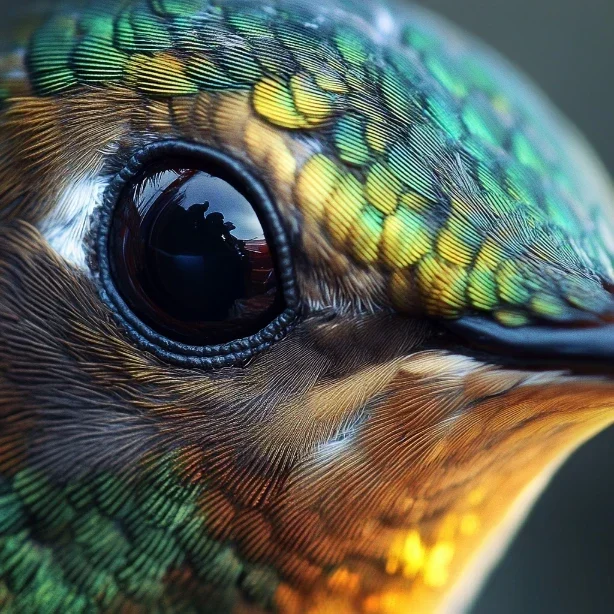(Or: How to Experience Life at High Definition)
In the realm of sensory perception, hummingbirds operate in a world that makes human senses seem like outdated technology. These remarkable creatures experience reality with a level of detail and precision that would overwhelm our neural circuitry. Their sensory capabilities push the boundaries of what biologists thought possible in a vertebrate nervous system.
The Visual Virtuosos
Imagine seeing colors we can’t even name, processing movement with the precision of a high-speed camera, and maintaining perfect spatial awareness while flying backwards. This is the daily reality of hummingbird vision. Their eyes have evolved to process visual information at rates that would make a computer engineer jealous.
Key visual capabilities include:
- Ability to see ultraviolet light spectrums invisible to humans
- Visual processing speed four times faster than human perception
- Enhanced motion detection that allows them to navigate at high speeds
The sophistication of their visual system extends beyond mere acuity. Hummingbirds can simultaneously process forward and lateral motion, maintaining precise spatial awareness even while flying backwards or hovering. They perceive the world in a continuous high-definition stream that helps them navigate through complex environments at remarkable speeds.
The Time Perception Masters
Hummingbirds experience time differently than most other creatures. Their metabolic rate and neural processing speed allow them to perceive the world as if it were moving in slow motion. What appears as a blur to human eyes registers as distinct, manageable movements to a hummingbird’s brain.
Temporal processing advantages include:
- Ability to distinguish wing beats in other birds
- Precise timing for aerial maneuvers
- Enhanced prediction of moving objects’ trajectories
This unique perception of time proves crucial for their survival, allowing them to navigate through dense vegetation, avoid predators, and capture tiny insects in mid-flight with remarkable precision.
The Balance Wizards
The vestibular system of a hummingbird represents one of nature’s most sophisticated equilibrium mechanisms. They maintain stability during maneuvers that would disorient fighter pilots, all while processing spatial information from multiple directions simultaneously.
Their balance capabilities include:
- Perfect hovering stability in variable conditions
- Instant adjustment to wind gusts
- Maintenance of orientation during backward flight
Consider how they can transition from forward flight at 30 miles per hour to a perfect hover in a fraction of a second, then move sideways or backwards without losing their sense of position. This requires a level of sensory integration that continues to amaze researchers.
The Touch Specialists
While we often focus on their aerial abilities, hummingbirds possess incredibly sensitive tactile systems. Their bills contain sophisticated touch sensors that help them gauge nectar levels and flower structures with remarkable precision.
Tactile sensitivities include:
- Microscopic pressure detection in bill tip
- Instant feedback about nectar quality
- Fine motor control for nest building
This refined sense of touch allows them to extract nectar from flowers with surgical precision, build intricate nests, and care for their tiny offspring with remarkable delicacy.
The Sound Perceivers
Though not typically known for their auditory abilities, hummingbirds possess sophisticated hearing capabilities that help them navigate their world. They can detect and process sounds across a remarkable frequency range, including vocalizations beyond human hearing.
Auditory capabilities include:
- Detection of subtle frequency variations
- Recognition of specific flower vibrations
- Processing of complex territorial calls
Their ability to detect and interpret sounds plays a crucial role in everything from territorial defense to courtship behavior.
The Weather Forecasters
Hummingbirds demonstrate an uncanny ability to predict and respond to weather changes before they become apparent to human observers. Their sensory systems integrate multiple environmental cues to create a sophisticated weather awareness system.
Environmental sensing includes:
- Detection of barometric pressure changes
- Recognition of approaching storm systems
- Awareness of temperature gradients
This meteorological sensitivity helps them prepare for weather changes that could impact their survival, allowing them to adjust their feeding patterns and seek shelter ahead of dangerous conditions.
Conclusion: Living in High Definition
The sensory world of hummingbirds represents one of nature’s most sophisticated information processing systems. These tiny birds experience reality with a level of detail and precision that humans can barely imagine, let alone comprehend.
Remember: When you observe a hummingbird navigating its environment with seeming ease, you’re witnessing the product of millions of years of sensory evolution operating at peak efficiency.
Post Script: Some neurobiologists suspect hummingbirds might perceive aspects of reality we haven’t even discovered yet. The birds maintain their characteristic focus on the task at hand, but their remarkable sensory capabilities suggest they might experience the world in ways we’re still trying to understand.


